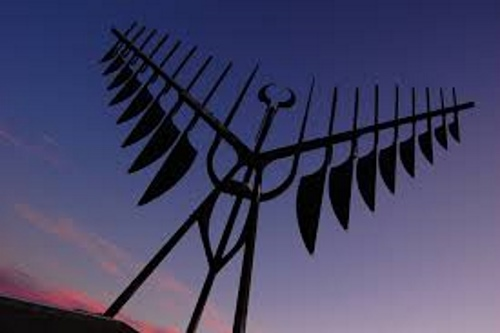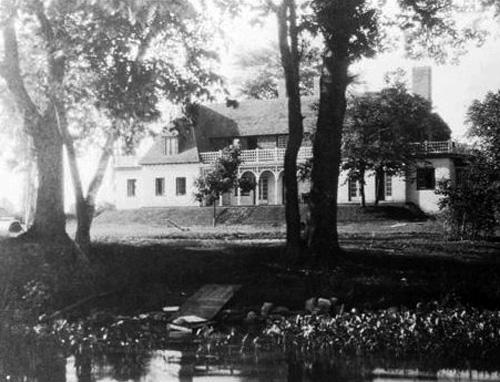 Toronto cyclists know how hard it is to get beyond the roller coaster nightmare of Toronto traffic to Elysium fields. Ok, dreary fields of GMO corn and soybeans, but it’s a step up from strip malls. Relying on The Canadian Cycling Association’s Complete Guide to Bicycle Touring in Canada (1994), I fashioned a trip to meet the litmus test:
Toronto cyclists know how hard it is to get beyond the roller coaster nightmare of Toronto traffic to Elysium fields. Ok, dreary fields of GMO corn and soybeans, but it’s a step up from strip malls. Relying on The Canadian Cycling Association’s Complete Guide to Bicycle Touring in Canada (1994), I fashioned a trip to meet the litmus test:
Lake Simcoe is tantalizingly close, more friendly than big Lake Ontario, but featuring a tightly packed string of cottages possessing every bit of lake front available.
Undaunted, I thought it was worth a try. The rapidly expanding Go bus/train system reaches as far as Barrie,
where there is an exquisite coastal path-promenade for city dwellers, and a Rail Trail to Orillia, where Stephen Leacock made his summer home, his modest estate now Orillia’s pride and joy. I asked myself: perhaps there is enough access to scenery to warrant a short adventure there and back from Barrie?
Rail Trail railings
I checked out Couchsurfing and was offered a bed by two different hosts -- a wealth of riches. Small towns are definitely friendlier than the big city. I took the first offer from Lisa and Scott, who turned out to be veteran skydivers, coasting down after a life of incredible exploits, world travellers. Neither they nor anyone else (except for the handful of cyclists actually on it) had much use for the Rail Trail, which like rail trails in Bruce County and elsewhere are the leftover rail corridors, straight as arrows through bush. Late 19th century -- early 20th century narrow gauge commuter trains shunted lumber, grain and tourists from Barrie to Orillia before the 'era of the auto'.
That Great Leap Forward put paid to earlier less polluting means of transport, and it was no problem just tearing up the now worthless tracks and handing the track bed over to cyclists -- a sop to the 'era of the bicycle'.
cyclists -- a sop to the 'era of the bicycle'.
But clearly cyclists didn’t have much say in the matter. Riding in a straight line through bush is tedious, like a pretty treadmill. But worse yet, it was decided to dump salty sand (from winter highways) and gravel for the unwitting cyclists, which any cyclists worth his/her salt knows is a practical joke, making a leisurely jaunt into a permanently uphill slog, best at a slow speed to avoid sliding off into oblivion as you slowly go mad. You might be better just putting your bike on auto-pilot and taking a snooze.
And it’s mostly paralleling a secondary but well paved Ridge Road, a Heritage road from settler days, which is, to channel Leacock, like cycling through Heaven, in comparison to the unlovable rail bones thrown to the cycling dogs by the car lords.
Why not just widen the shoulders and, voila! a great bike path? The road has open vistas. Fields and forest are much better scenery that a narrow path through trees.
I tolerated a mile and a half or two between the paved county lines, and then abandoned it, riding mostly on the cottagers’ Lakeshore Drive, discovering the gaps which cut the ‘drive’ due to private property rights, and resorting to the Rail Trail to cover them, unaware till I was almost at Orillia, that the Ridge Road (Highway 20 on maps) was the best route. Lesson: beware of maps and advice that are just plain wrong!
My return trip to Barrie was much better, with the wrinkles in the messy road/trail scenario ironed out. The best route is a combination of Lakeshore Drive, peeping through the trees, with occasional gaps for boat launching and two actual parks for peons near Oro, one under renovation so unusable, the other Shelsworth Park, tiny but with a small pebbly beach and enough open space to include, across the quiet cottagers’ road, a basketball court and slides for kids.
Riding most of the way back on Ridge Road, with a few detours down to the lake for an icy dip, this time aware of the Lakeshore Drive gaps, was a joy, though I still had to ask every available target to make sure I wasn’t going down a dead end. But then, getting sort of lost and relying on the kindness of strangers is part of the fund of traveling, especially bipedal.
I was fortunate that the second day was rainy, so Lisa and I went to the Orillia library, where Lisa, as an Orillian, wanted to request they purchase my latest book, which is a Canadian-Palestinian history primer, so should be of interest. The library worker was dismissive, clearly hostile to an uppity Torontonian with his Lisa-come-lately ‘Orillian’. I foolishly explained that this is common procedure in Toronto libraries, which just made matters worse.
Leacock legacy
Ahh, my first real taste of Leacock, who might have included an exaggerated version of the officious ice queen in one of his sketches. I read up on Leacock before leaving and found a fascinating fellow. His bestsellers -- Sunshine Sketches in a Little Town (1912) about Mariposa/ Orillia, and Arcadian Adventures of the Idle Rich (1914) -- which takes place in a private club on Plutoria Avenue in 'a large city'/ Toronto) were surprisingly not in my local Toronto library, Lillian Smith, though it is the largest Toronto branch library. Strangely, his complete letters were. Six hundred pages, mostly about royalties, contracts, but some revealing a devoted, if conflicted, son and husband/father.
Leacock was the third of 11 children, and clearly hit the gene jackpot, the star in the family, though his own family life was tragic. He married Beatrix Hamilton, niece of Sir Henry Pellatt, of Toronto's Casa Loma, in 1900. In 1915, after 15 years of marriage, the couple had their only child, Stephen Lushington Leacock. who suffered from a lack of growth hormone. Growing to be only four feet tall, he had a love-hate relationship with Leacock. Beatrix died in 1925 due to breast cancer.
By then he was the best-known English-speaking humorist in the world, as well as a tenured economics professor at McGill. A staunch imperialist, a fine example of the Victorian 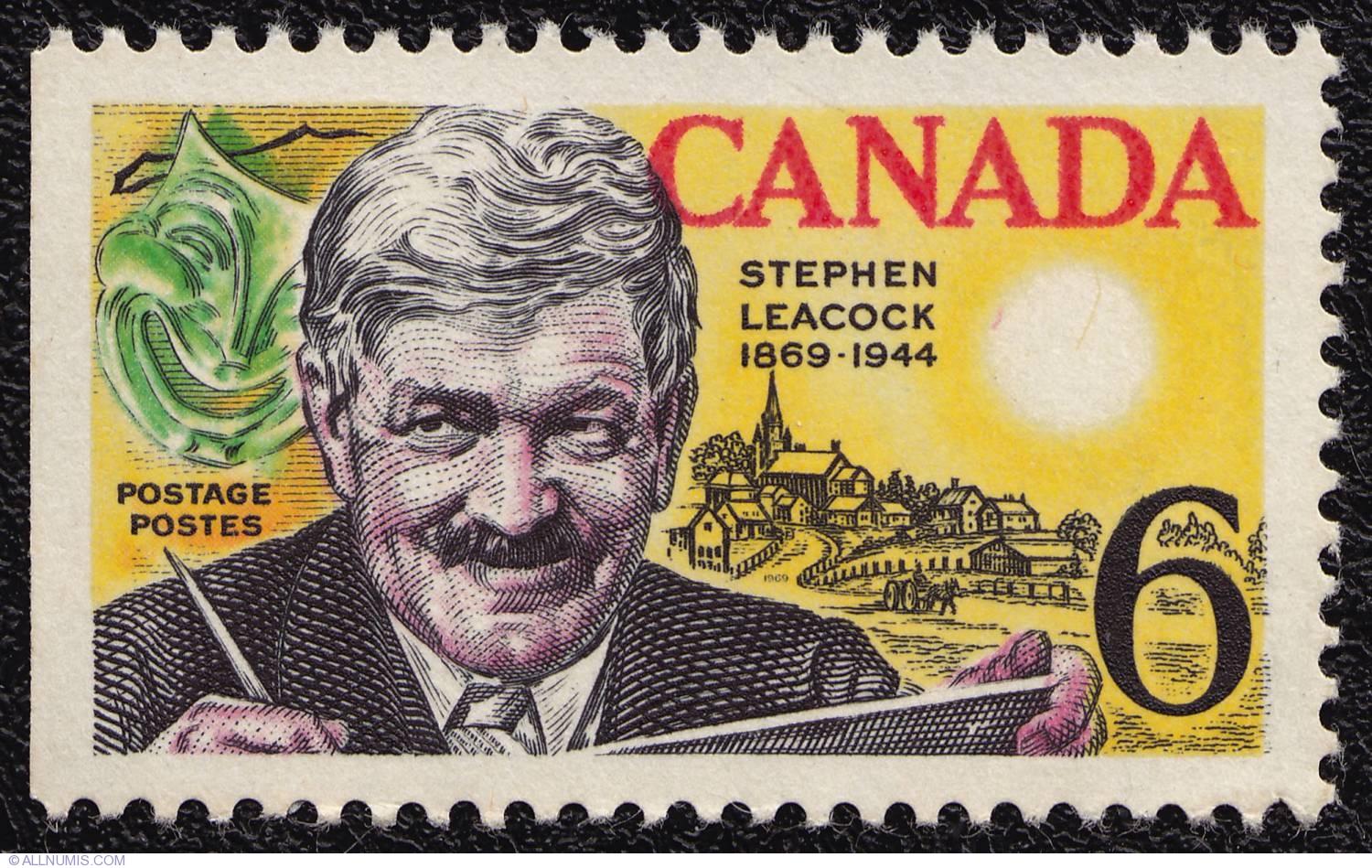 self-made man, he attracted the attention of Governor General Lord Grey, who sponsored him on a tour of eastern Canada in 1907. Cecil Rhodes, the arch-imperial conspirator always on the lookout for charismatic young men to carry his empire forward, invited Leacock to take his lively wit and pompous warhorse imperialism to England, South Africa, Australia and New Zealand on behalf of the Cecil Rhodes Trust Fund in 1907--08. He wrote about his luxury world tour to his mother, and these letters are a window into the imperial glory, the British Empire’s ‘finest’ moment, just before the world war death throes were about to begin.
self-made man, he attracted the attention of Governor General Lord Grey, who sponsored him on a tour of eastern Canada in 1907. Cecil Rhodes, the arch-imperial conspirator always on the lookout for charismatic young men to carry his empire forward, invited Leacock to take his lively wit and pompous warhorse imperialism to England, South Africa, Australia and New Zealand on behalf of the Cecil Rhodes Trust Fund in 1907--08. He wrote about his luxury world tour to his mother, and these letters are a window into the imperial glory, the British Empire’s ‘finest’ moment, just before the world war death throes were about to begin.
Leacock was a ‘good imperialist’, a red Tory. “In opposition to liberal individualism, the Tory sees society as an organic unity in which everyone has his duties as well as his rights,”* seeing society maturing naturally and slowly, not looking to some abstract utopia, the work of wild-eyed revolutionaries or captains of finance and industry.
He was surely ‘in’ on Rhodes’s vision of a British Imperial Commonwealth, where the newly ‘independent’ colonies would maintain their union with the motherland, and hopefully draw the wayward Americans back into the fold, though Leacock, like most Canadians, was wary of America, now exercising, very crudely, its own imperial ambitions. In the 1930s, he wrote the introduction for a collection of R.B. Bennett’s speeches. The Conservative Prime Minister asked Leacock to be a candidate in the 1935 federal election.
I returned the next morning at 10am, with not a soul in sight, no expectant tourists, and decided to act out a Leacock nonsense sketch, incarnating his spirit walking to the boathouse through the flowerbed to the small wooded glen to the private shore, where I sat under an oak tree, enjoying the morning sunshine, sketching in my mind another 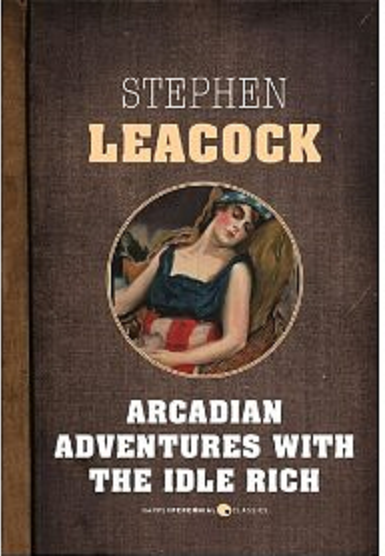 vignette of small town life in northern Ontario, featuring quirky locals, tedious jobs, sloppy transport ‘planning’, spite and silliness. Leacock was a prodigy at this, whipping off these sketches throughout his life, though, unlike his idols Dickens and Twain, with little concern for honing his style or producing ‘less but better’.
vignette of small town life in northern Ontario, featuring quirky locals, tedious jobs, sloppy transport ‘planning’, spite and silliness. Leacock was a prodigy at this, whipping off these sketches throughout his life, though, unlike his idols Dickens and Twain, with little concern for honing his style or producing ‘less but better’.
His humour is now very dated. His model and a close friend was the slapstick Robert Benchley, who started at The Harvard Lampoon, writing essays and articles for Vanity Fair and The New Yorker and made short films for Hollywood, where his short film How to Sleep won Best Short Subject at the 1935 Academy Awards. Perhaps Leacock would still be appreciated if his and Rhodes’s vision had triumphed, but the naivete of vaudeville paled in a century of ideology and war, and gentle sarcasm poking fun at the rich just didn’t cut the mustard.
Leacock’s nemesis
The rain didn’t let up and Lisa and I were enjoying our company so she suggested a trip up to Gravenhurst to visit the museum of very different Canadian icon, Norman Bethune. His life is night to Leacock’s sunny day. He signed up in 1914 and fought in first the army, then (with a foot injury) did his four year medical degree in a crash one year wartime emergency policy, then returned to the navy and jumped ship to the air force.
He discovered he had a fatal case of TB, but insisted on a radical new operation to collapse his infected lung, recovered, and promptly joined the Communist Party, going first to the Soviet Union (along with Banting)*** to see the social medical system, then to Spain with his invention of a mobile transfusion truck, ending up in China to work with Mao Zedong, dying of blood poisoning on the front line against the Japanese invaders. Whew!
The spring busloads of Chinese pilgrims had started. Mike is a new millionaire from Guangzhou. The museum has a fine historical display, shows the dynamite NFB documentary on 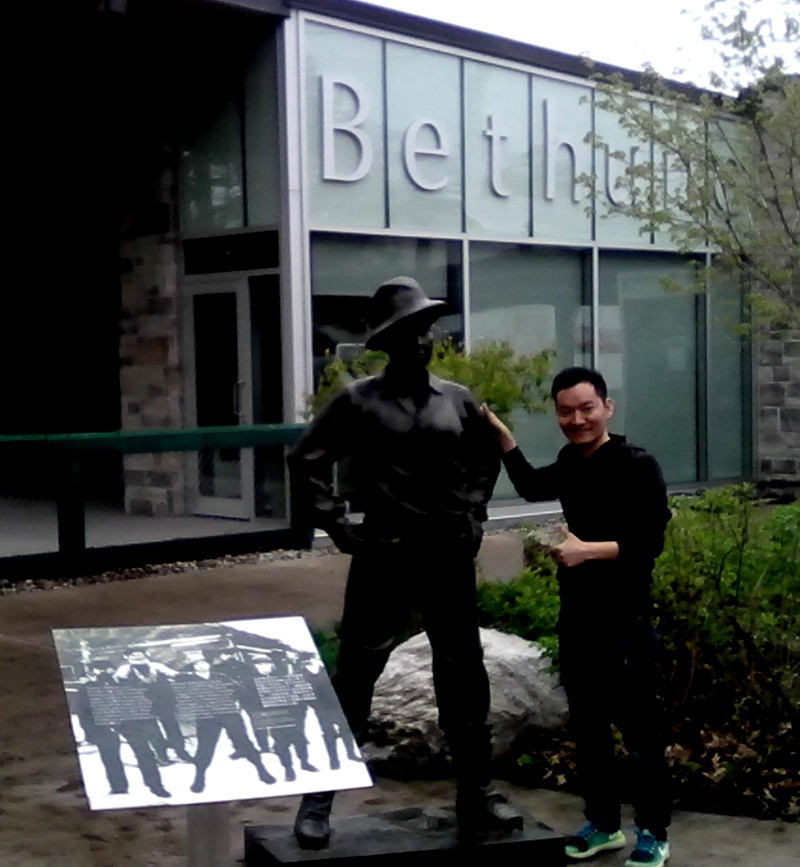 Bethune, including his tempestuous love life and brilliance as a painter/ poet, and his irascible impatience with the Leacocks and Leacock’s small town hypocrites of the world. The exhibits are in Chinese and English, with a beautiful scroll with Mao’s long appreciation of Bethune reverently displayed. The (Chinese) guide relates that children in China still memorize it and recite it at school. Bethune’s name is Bai Qin En (light preserves kindness).
Bethune, including his tempestuous love life and brilliance as a painter/ poet, and his irascible impatience with the Leacocks and Leacock’s small town hypocrites of the world. The exhibits are in Chinese and English, with a beautiful scroll with Mao’s long appreciation of Bethune reverently displayed. The (Chinese) guide relates that children in China still memorize it and recite it at school. Bethune’s name is Bai Qin En (light preserves kindness).
Bethune’s predecessors and family are almost as remarkable as he is, and his whirlwind life is far more inspiring than Leacock’s coy frolic, which is remembered (if limply), as opposed to Bethune’s, which is too shocking, too angry, too real for us. Fascinating that the now capitalist Chinese revere him and have no idea who Leacock, a rather sad, imperial anachronism, is. Leacock was also invited to visit the Soviet Union but categorically refused.
Not surprisingly, all evidence of Orillia's rich native heritage is gone. Only the tiny reserve across the bay is left of their territory. The Chippewas of Rama Mnjikaning First Nation, is an Anishinaabe (Ojibway) First Nation, Mnjikaning meaning “near the fence”, referring to the wooden stake fishing weirs at Atherley Narrows between Lake Simcoe and Lake Couchiching, used to catch fish, built 4,500 years ago. They are now a Heritage Site, but are submerged as a result of white geo-engineering to allow steamboat and now yachts to use the narrows.
The reserve, 2,350 acres of land on eight separate parcels, with 1600 members, is popularly called Rama, with the Casino Rama the focal point. The Chippewas of Lakes Huron and Simcoe were part of the Coldwater experiment in 1836, which was in fact a ruse to dispossess and assimilate the natives, who were told the whites needed 'a bit more land for their relatives'. By the time the relatives had come, all but a few parcels of the worst land were gone, the Chippewas reduce to a few hundreds.
The Mnjikaning First Nation prides itself as having long been involved in tourism, guiding the French and British when they first arrived. They were hunter gatherers, and were easily displaced by land-hungry farmers.Their foray into gambling is not totally cynical. They see it as just another white man's vice (no better or worse than all the others), and 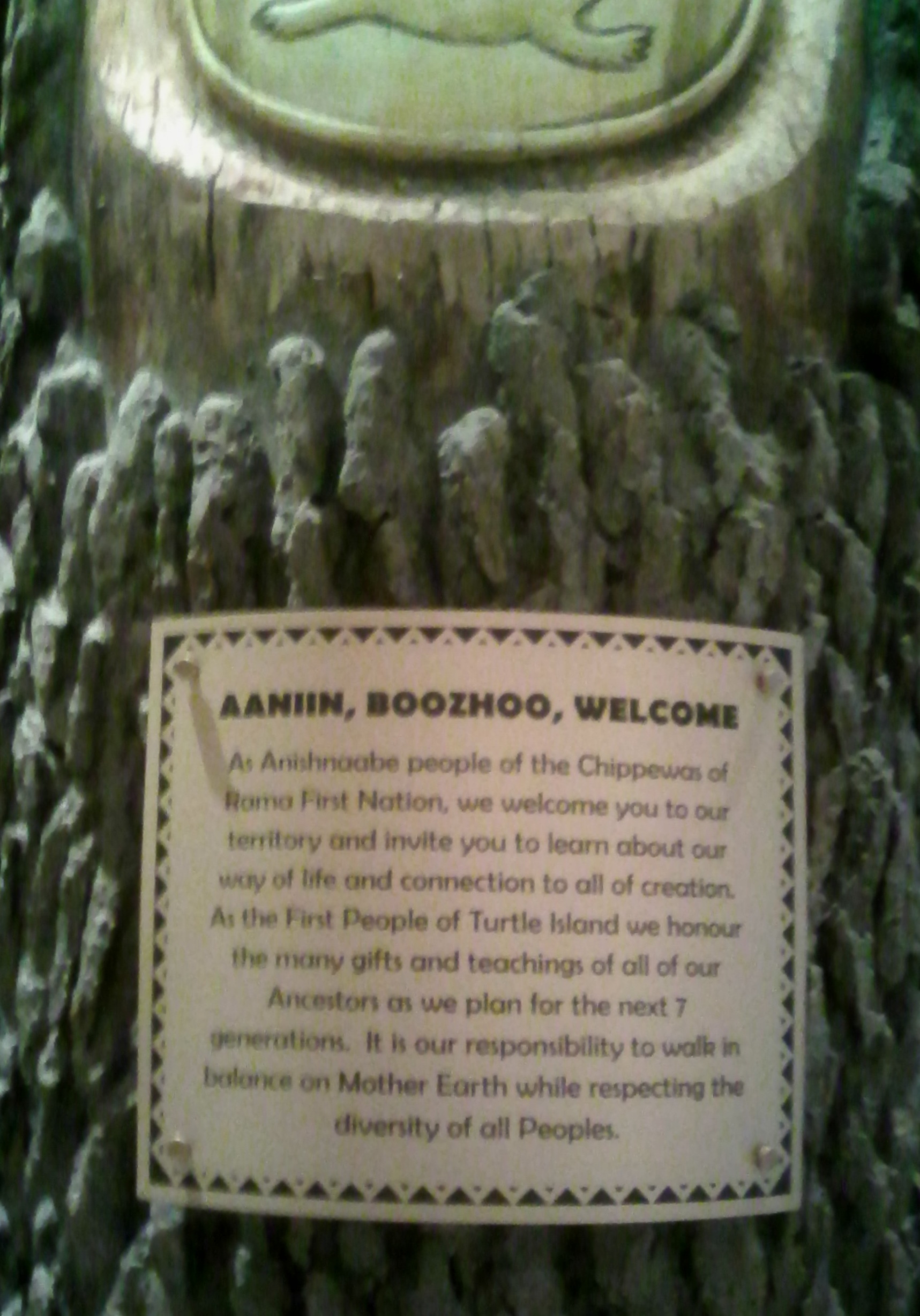 depict it as representing all four races of man coming together to take a rest. It is designed and decorated with native motifs, and is less oppressive than other casinos, full of anxious obsessives. The facilities also host rock concerts (Alice Cooper), attracting Canadians from both Quebec and Ontario.
depict it as representing all four races of man coming together to take a rest. It is designed and decorated with native motifs, and is less oppressive than other casinos, full of anxious obsessives. The facilities also host rock concerts (Alice Cooper), attracting Canadians from both Quebec and Ontario.
The Mnjikaning have not had it as bad a time as other tribes, not suffering the devastating residential school syndrome. Once the land was seized, Orillia's size and remoteness left them more or less alone, and now the handful remaining are able to recover without the negative associations that most other natives must deal with.
The reserve library was modern and well equipped. The library worker was delighted in my book, dealing with native history in a sympathetic way, and was hopeful that their librarian would approve it. A nice contrast with the snooty reception I received earlier that day in 'Mariposa'.
White ghosts
The colonial settlers were after the one thing denied them in their motherland: land. They came, they saw, they took. By the 20th century, agriculture gave way to leisure activities, and the new land craze was for prime lakeside property. Soon the entire lake was taken, apart from Georgina Island and Chiefs Island, a sacred burial ground in the northern part, Lake Couchiching.
But that is not the way the law sees it. Water and shoreline are crown property. Provinces vary in specifying what that means. Manitoba’s Crown Lands Act reserves the bed of a body of water and a strip of land 30 metres from the high water mark for the crown. If land borders a navigable waterway, the crown also reserves “the public right of landing from, and mooring, boats and vessels so far as is reasonably necessary.”
That should mean that bike travels along lakefront should be perfectly ok, though convincing cottagers of that just might be problematic. Elegant fences on some massive ‘cottages’ even extend a few yards into the lake, just in case you had any doubt. Sadly, private ‘property’ trumps not only native ‘laws’ but our very own European laws. There are no roads around Lake Simcoe for even car drivers to enjoy the view.
The children of Leacocks’ ‘plutocrats’ may have to accommodate themselves to the idea of nice cyclists passing along their waterfront homes. That was the fate of cottagers in many
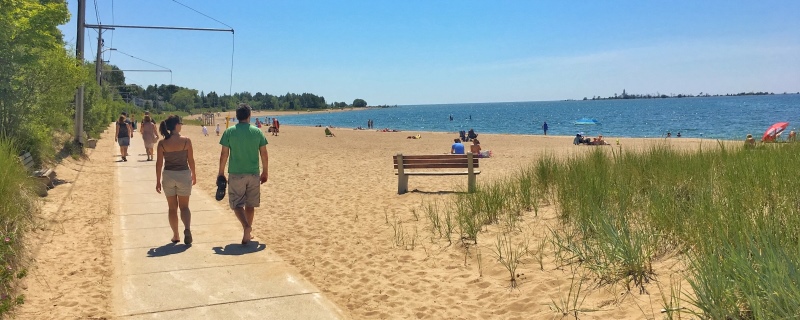 other areas, notably nearby Southhampton, where the boardwalk along the sandy shore is now treated as a plus to all.
other areas, notably nearby Southhampton, where the boardwalk along the sandy shore is now treated as a plus to all.